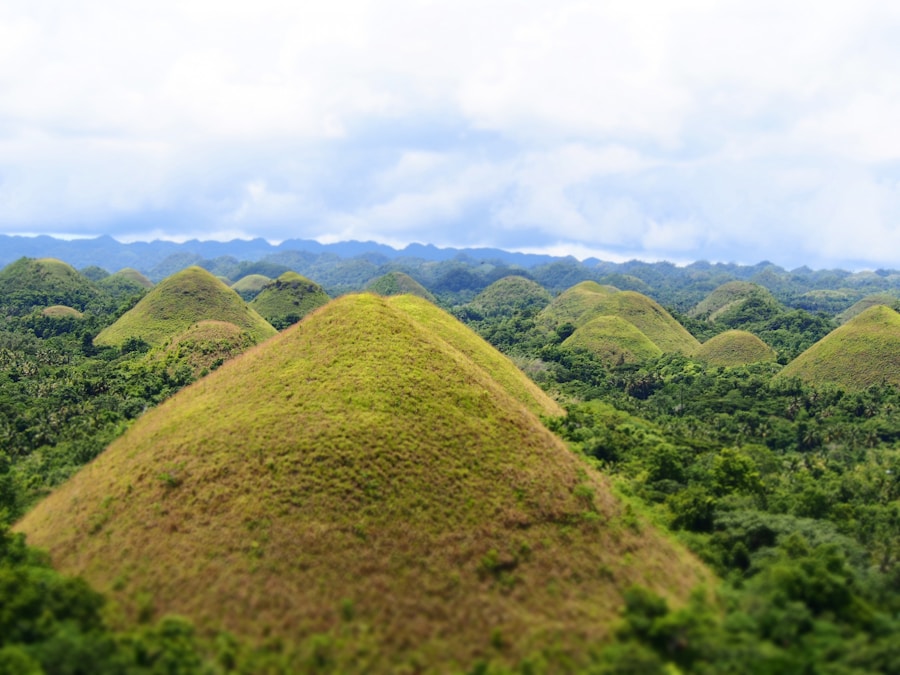Download links
How to install Exploring the Majestic Chocolate Hills APK?
1. Tap the downloaded Exploring the Majestic Chocolate Hills APK file.
2. Touch install.
3. Follow the steps on the screen.
Description
The Chocolate Hills, a geological wonder located in the Bohol province of the Philippines, are a striking natural formation that has captivated visitors and researchers alike.
The formation of these hills is attributed to a combination of geological processes that took place over millions of years.
Primarily, they are composed of limestone, which has been shaped by the forces of erosion and weathering. The process began during the Pleistocene epoch when the area was submerged underwater. Over time, the uplift of the land and the subsequent exposure to the elements led to the gradual erosion of the limestone, resulting in the distinctive conical shapes that we see today.
The Chocolate Hills are not merely a product of erosion; they also reflect the complex interplay of natural forces. Rainwater, rich in carbon dioxide, seeps into the ground and reacts with the limestone, creating a phenomenon known as karst topography. This process leads to the dissolution of the limestone, forming sinkholes and depressions that contribute to the hills’ unique shapes.
The hills are particularly striking during the dry season when the grass covering them turns brown, resembling chocolate mounds. This seasonal transformation is a key reason behind their name and adds to their allure as a tourist destination. The geological history of the Chocolate Hills is not only fascinating but also serves as a reminder of the dynamic processes that shape our planet.
Key Takeaways
- The Chocolate Hills were formed by the uplift of coral deposits and the action of rainwater and erosion over millions of years.
- Visitors can enjoy breathtaking views and numerous photo opportunities from the viewing deck at the Chocolate Hills Complex.
- The area is home to a diverse range of flora and fauna, including various species of plants, birds, and butterflies.
- Local legends and myths surrounding the Chocolate Hills include stories of giants and tears shed by a grieving giantess.
- Visitors can engage in activities such as ziplining, ATV riding, and exploring nearby attractions like the Tarsier Conservation Area.
- Conservation efforts are underway to preserve the natural beauty and ecological significance of the Chocolate Hills for future generations.
Breathtaking Views and Photo Opportunities
Panoramic Views from the Observation Deck
From the Chocolate Hills Complex, which features an observation deck that rises above the hills, tourists can take in panoramic views that showcase the undulating terrain and the vast expanse of nature surrounding it. The experience is further enhanced by the clear blue skies that often serve as a backdrop, making it an ideal setting for photography enthusiasts.
Unique Lighting Conditions
Photographers flock to this location not only for its natural beauty but also for the unique lighting conditions that change throughout the day. Early morning and late afternoon provide soft, golden light that enhances the colors of the hills, creating dramatic contrasts and shadows. Many visitors take advantage of these moments to capture stunning images that highlight the hills’ distinctive shapes and textures.
A Popular Subject for Social Media
The Chocolate Hills have become a popular subject for social media posts, with countless travelers sharing their experiences and photographs online, further solidifying its status as a must-visit destination.
Flora and Fauna of the Chocolate Hills

The ecological diversity surrounding the Chocolate Hills is as remarkable as their geological features. The area is home to a variety of flora and fauna that thrive in this unique environment. The hills are primarily covered with grass, which turns brown during the dry season but bursts into vibrant green during the rainy months.
This seasonal change not only enhances the visual appeal of the landscape but also supports a range of wildlife. Various species of birds can be spotted soaring above or perched on trees, while small mammals and reptiles inhabit the lower vegetation. The rich biodiversity contributes to the ecological balance of the region and offers opportunities for nature enthusiasts to observe wildlife in its natural habitat.
In addition to native species, some areas around the Chocolate Hills have been designated as protected zones to preserve their ecological integrity. Conservation efforts focus on maintaining habitats for endemic species and promoting sustainable tourism practices. Local organizations work tirelessly to educate visitors about the importance of preserving this unique ecosystem while allowing them to enjoy its beauty.
Guided tours often include information about the various plants and animals found in the area, providing an enriching experience for those interested in learning more about Bohol’s natural heritage. The interplay between geology and ecology at the Chocolate Hills creates a dynamic environment that continues to intrigue scientists and nature lovers alike.
Local Legends and Myths Surrounding the Chocolate Hills
| Legend/Myth | Description |
|---|---|
| The Legend of Arogo | Arogo, a giant who fell in love with a mortal woman, cried tears that turned into the Chocolate Hills when she died. |
| The Legend of Two Fighting Giants | Two giants fought for days, throwing rocks and sand at each other, and the Chocolate Hills were formed from their battle. |
| The Legend of the Weeping Maiden | A beautiful maiden cried tears of sorrow, which turned into the Chocolate Hills when she was turned into stone. |
| The Legend of the Chocolate Hills | The hills are said to be the remnants of a giant’s leftover chocolate after a feast. |
The Chocolate Hills are steeped in local legends and myths that add an enchanting layer to their allure.
As they fought, they hurled boulders at each other, creating chaos across the landscape.
Eventually, they grew tired of their conflict and decided to bury their weapons, leaving behind only the hills as a reminder of their struggle. This story not only explains the origin of the hills but also reflects the rich cultural heritage of Boholano folklore. Another legend speaks of a giant who fell in love with a mortal woman.
Heartbroken when she rejected him, he wept bitterly, and his tears formed the hills we see today. This narrative highlights themes of love and loss while providing a mythical explanation for the hills’ unusual shapes. Such stories are often shared among locals and visitors alike, enriching their experience at this natural wonder.
The legends surrounding the Chocolate Hills serve as a testament to how cultural narratives can shape our understanding of natural phenomena, blending history with imagination.
Activities and Attractions in the Surrounding Area
Beyond simply admiring the Chocolate Hills, visitors can engage in a variety of activities that enhance their experience in this stunning region. One popular option is hiking or biking along designated trails that wind through and around the hills. These trails offer an up-close view of the landscape while allowing adventurers to immerse themselves in nature.
Guided tours often include stops at lesser-known viewpoints where tourists can enjoy solitude away from larger crowds while still taking in breathtaking vistas. In addition to outdoor activities, visitors can explore nearby attractions that complement their trip to the Chocolate Hills. One such destination is the Tarsier Sanctuary, home to one of the world’s smallest primates—the Philippine tarsier.
This sanctuary provides an opportunity to observe these adorable creatures in their natural habitat while supporting conservation efforts aimed at protecting them from extinction. Another nearby attraction is Loboc River, where visitors can take scenic boat rides through lush landscapes while enjoying traditional Filipino music performed by local artists on floating restaurants. These activities not only enhance one’s appreciation for Bohol’s natural beauty but also provide insight into its rich cultural heritage.
Conservation Efforts and Future of the Chocolate Hills

As awareness grows regarding environmental issues and sustainable tourism practices, conservation efforts surrounding the Chocolate Hills have become increasingly important. Local government units and non-governmental organizations are actively involved in initiatives aimed at preserving this unique geological formation while promoting responsible tourism. These efforts include reforestation projects to restore native vegetation around the hills and educational programs designed to inform visitors about ecological preservation.
The future of the Chocolate Hills hinges on balancing tourism with conservation efforts. As more travelers flock to this iconic destination, it is crucial to implement measures that protect its natural beauty while ensuring that local communities benefit from tourism revenue. Sustainable practices such as limiting visitor numbers during peak seasons or encouraging eco-friendly accommodations can help mitigate environmental impacts while enhancing visitor experiences.
By fostering a culture of respect for nature among tourists and locals alike, there is hope that future generations will continue to marvel at this extraordinary landscape for years to come. In conclusion, the Chocolate Hills stand as a testament to nature’s artistry and resilience, shaped by geological processes over millennia while enriched by local legends and vibrant ecosystems. As visitors explore this breathtaking destination, they not only witness its beauty but also engage with its cultural significance and ecological importance.
Through ongoing conservation efforts and responsible tourism practices, there is potential for these iconic hills to thrive well into the future, continuing to inspire awe and wonder in all who encounter them.
FAQs
What are the Chocolate Hills?
The Chocolate Hills are a geological formation in the Bohol province of the Philippines. They are made up of around 1,268 cone-shaped hills, which are covered in green grass that turns brown during the dry season, giving them the appearance of chocolate kisses.
How were the Chocolate Hills formed?
The exact formation process of the Chocolate Hills is still a subject of debate among geologists. However, it is widely believed that they are the result of the uplift of coral deposits and the action of rainwater and erosion over millions of years.
What is the best time to visit the Chocolate Hills?
The best time to visit the Chocolate Hills is during the dry season, which typically runs from late November to May. This is when the grass covering the hills turns brown, giving them their chocolate-like appearance.
Are there any activities to do at the Chocolate Hills?
Visitors to the Chocolate Hills can enjoy activities such as hiking, bird watching, and taking in the panoramic views from the viewing deck. There are also ATV tours and zip lining available for those seeking a more adventurous experience.
Is there an entrance fee to visit the Chocolate Hills?
Yes, there is an entrance fee to visit the Chocolate Hills. The fee helps with the maintenance and preservation of the area.





